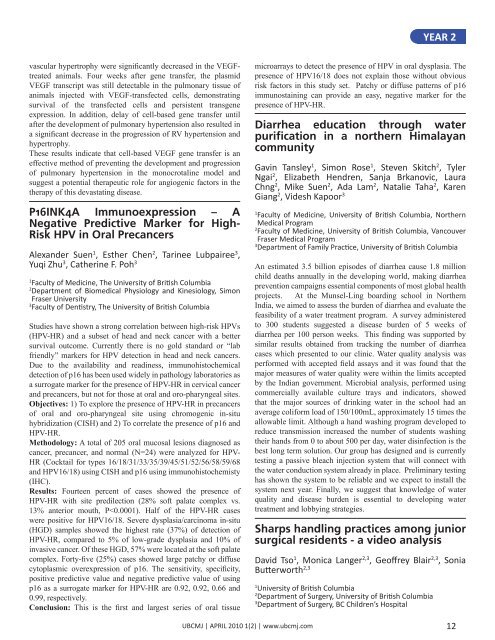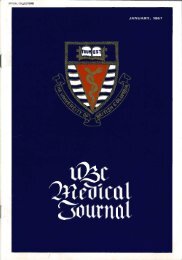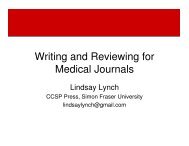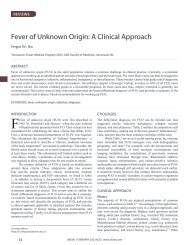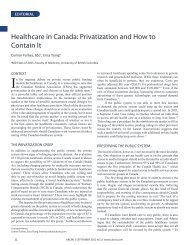Download full PDF - UBC Medical Journal
Download full PDF - UBC Medical Journal
Download full PDF - UBC Medical Journal
You also want an ePaper? Increase the reach of your titles
YUMPU automatically turns print PDFs into web optimized ePapers that Google loves.
YEAR 2<br />
vascular hypertrophy were significantly decreased in the VEGFtreated<br />
animals. Four weeks after gene transfer, the plasmid<br />
VEGF transcript was still detectable in the pulmonary tissue of<br />
animals injected with VEGF-transfected cells, demonstrating<br />
survival of the transfected cells and persistent transgene<br />
expression. In addition, delay of cell-based gene transfer until<br />
after the development of pulmonary hypertension also resulted in<br />
a significant decrease in the progression of RV hypertension and<br />
hypertrophy.<br />
These results indicate that cell-based VEGF gene transfer is an<br />
effective method of preventing the development and progression<br />
of pulmonary hypertension in the monocrotaline model and<br />
suggest a potential therapeutic role for angiogenic factors in the<br />
therapy of this devastating disease.<br />
P16INK4A Immunoexpression – A<br />
Negative Predictive Marker for High-<br />
Risk HPV in Oral Precancers<br />
Alexander Suen 1 , Esther Chen 2 , Tarinee Lubpairee 3 ,<br />
Yuqi Zhu 3 , Catherine F. Poh 3<br />
1<br />
Faculty of Medicine, The University of British Columbia<br />
2<br />
Department of Biomedical Physiology and Kinesiology, Simon<br />
Fraser University<br />
3<br />
Faculty of Dentistry, The University of British Columbia<br />
Studies have shown a strong correlation between high-risk HPVs<br />
(HPV-HR) and a subset of head and neck cancer with a better<br />
survival outcome. Currently there is no gold standard or “lab<br />
friendly” markers for HPV detection in head and neck cancers.<br />
Due to the availability and readiness, immunohistochemical<br />
detection of p16 has been used widely in pathology laboratories as<br />
a surrogate marker for the presence of HPV-HR in cervical cancer<br />
and precancers, but not for those at oral and oro-pharyngeal sites.<br />
Objectives: 1) To explore the presence of HPV-HR in precancers<br />
of oral and oro-pharyngeal site using chromogenic in-situ<br />
hybridization (CISH) and 2) To correlate the presence of p16 and<br />
HPV-HR.<br />
Methodology: A total of 205 oral mucosal lesions diagnosed as<br />
cancer, precancer, and normal (N=24) were analyzed for HPV-<br />
HR (Cocktail for types 16/18/31/33/35/39/45/51/52/56/58/59/68<br />
and HPV16/18) using CISH and p16 using immunohistochemisty<br />
(IHC).<br />
Results: Fourteen percent of cases showed the presence of<br />
HPV-HR with site predilection (28% soft palate complex vs.<br />
13% anterior mouth, P


